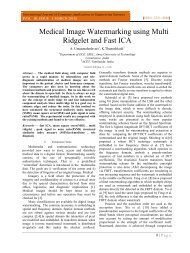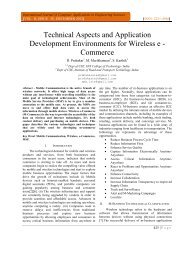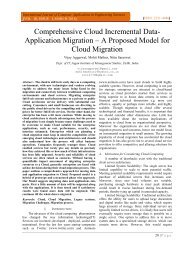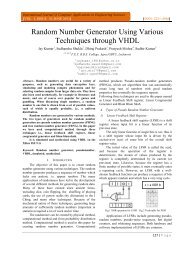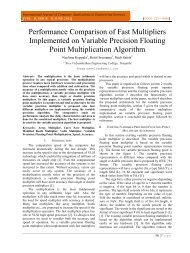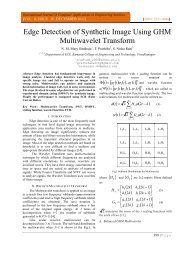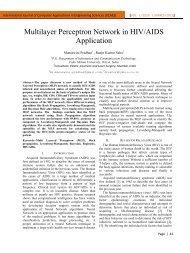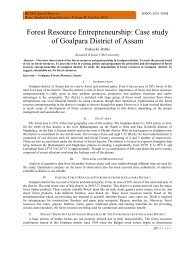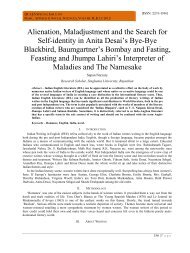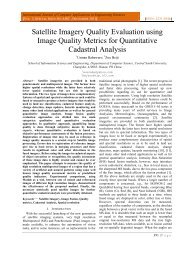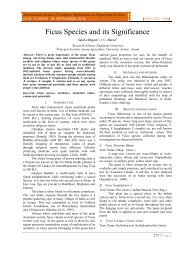Comparison of DDOS Attacks and Fast ICA Algorithms on The Basis ...
Comparison of DDOS Attacks and Fast ICA Algorithms on The Basis ...
Comparison of DDOS Attacks and Fast ICA Algorithms on The Basis ...
Create successful ePaper yourself
Turn your PDF publications into a flip-book with our unique Google optimized e-Paper software.
Internati<strong>on</strong>al Journal <str<strong>on</strong>g>of</str<strong>on</strong>g> Computer Applicati<strong>on</strong>s in Engineering Sciences[VOL I, ISSUE III, SEPTEMBER 2011] [ISSN: 2231-4946]<str<strong>on</strong>g>Comparis<strong>on</strong></str<strong>on</strong>g> <str<strong>on</strong>g>of</str<strong>on</strong>g> <str<strong>on</strong>g>DDOS</str<strong>on</strong>g> <str<strong>on</strong>g>Attacks</str<strong>on</strong>g> <str<strong>on</strong>g>and</str<strong>on</strong>g> <str<strong>on</strong>g>Fast</str<strong>on</strong>g> <str<strong>on</strong>g>ICA</str<strong>on</strong>g><str<strong>on</strong>g>Algorithms</str<strong>on</strong>g> <strong>on</strong> <strong>The</strong> <strong>Basis</strong> <str<strong>on</strong>g>of</str<strong>on</strong>g> Time ComplexityD. Raghu 1 , M. Arani 2 , Ch. Raja Jacob 31,2,3 Dept <str<strong>on</strong>g>of</str<strong>on</strong>g> Computer Science <str<strong>on</strong>g>and</str<strong>on</strong>g> Engineering, Nova College <str<strong>on</strong>g>of</str<strong>on</strong>g> Engineering & Technology,JNTU-K, Andhra Pradesh.1 raghuau@gmail.com, 2 aarani.mantena@gmail.com, 3 rchidipi@gmail.comAbstract— In Distributed denial <str<strong>on</strong>g>of</str<strong>on</strong>g> service (<str<strong>on</strong>g>DDOS</str<strong>on</strong>g>) attack,an attacker may use your computer to attack anothercomputer by taking security weakness an attacker couldtake c<strong>on</strong>trol <str<strong>on</strong>g>of</str<strong>on</strong>g> your computer. He could then force yourcomputer to send huge amounts <str<strong>on</strong>g>of</str<strong>on</strong>g> data to a website. Orsend spam particular email address. <strong>The</strong> “Attack” isdistributed because the attacker is using multiplecomputers including yours to enter the denial <str<strong>on</strong>g>of</str<strong>on</strong>g> serviceattack. DDoS attack is a c<strong>on</strong>tinuous critical threat to theInternet. Derived from the low layers, new applicati<strong>on</strong>layer-basedDDoS attacks utilizing legitimate HTTPrequests to overwhelm victim resources are moreundetectable. <strong>The</strong> case may be more serious when suchattacks mimic or occur during the flash crowd event <str<strong>on</strong>g>of</str<strong>on</strong>g> apopular Website. Distributed denial <str<strong>on</strong>g>of</str<strong>on</strong>g> service attacks <strong>on</strong>root name servers are several significant Internet events inwhich distributed denial-<str<strong>on</strong>g>of</str<strong>on</strong>g>-service attacks have targeted<strong>on</strong>e or more <str<strong>on</strong>g>of</str<strong>on</strong>g> the thirteen Domain Name System rootname servers. <strong>The</strong> root name servers are criticalinfrastructure comp<strong>on</strong>ents <str<strong>on</strong>g>of</str<strong>on</strong>g> the Internet, mappingdomain names to Internet Protocol (IP) addresses <str<strong>on</strong>g>and</str<strong>on</strong>g>other informati<strong>on</strong>. <str<strong>on</strong>g>Attacks</str<strong>on</strong>g> against the root name serverscan impact operati<strong>on</strong> <str<strong>on</strong>g>of</str<strong>on</strong>g> the entire Internet, rather thanspecific websites.Keywords— Applicati<strong>on</strong>-layer, Distributed denial <str<strong>on</strong>g>of</str<strong>on</strong>g>service (DDoS), Flash Crowd, Name Servers, <str<strong>on</strong>g>ICA</str<strong>on</strong>g>algorithm.I. INTRODUCTIONDistributed denial <str<strong>on</strong>g>of</str<strong>on</strong>g> service (DDoS) attack has causedsevere damage to servers <str<strong>on</strong>g>and</str<strong>on</strong>g> will cause even greaterintimidati<strong>on</strong> to the development <str<strong>on</strong>g>of</str<strong>on</strong>g> new Internetservices. Traditi<strong>on</strong>ally, DDoS attacks are carried out atthe network layer, such as ICMP flooding, SYNflooding, <str<strong>on</strong>g>and</str<strong>on</strong>g> UDP flooding, which are called Net-DDoS attacks in this paper. <strong>The</strong> intent <str<strong>on</strong>g>of</str<strong>on</strong>g> these attacks isto c<strong>on</strong>sume the network b<str<strong>on</strong>g>and</str<strong>on</strong>g>width <str<strong>on</strong>g>and</str<strong>on</strong>g> deny service tolegitimate users <str<strong>on</strong>g>of</str<strong>on</strong>g> the victim systems. Since manystudies have noticed this type <str<strong>on</strong>g>of</str<strong>on</strong>g> attack <str<strong>on</strong>g>and</str<strong>on</strong>g> haveproposed different schemes (e.g., network measure oranomaly detecti<strong>on</strong>) to protect the network <str<strong>on</strong>g>and</str<strong>on</strong>g>equipment from b<str<strong>on</strong>g>and</str<strong>on</strong>g>width attacks, it is not as easy as inthe past for attackers to launch the DDoS attacks based<strong>on</strong> network layer.When the simple Net-DDoS attacks fail, attackersshift their <str<strong>on</strong>g>of</str<strong>on</strong>g>fensive strategies to applicati<strong>on</strong>-layerattacks <str<strong>on</strong>g>and</str<strong>on</strong>g> establish a more sophisticated type <str<strong>on</strong>g>of</str<strong>on</strong>g> DDoSattacks. To circumvent detecti<strong>on</strong>, they attack the victimWeb servers by HTTP GET requests (e.g., HTTPFlooding) <str<strong>on</strong>g>and</str<strong>on</strong>g> pulling large image files from the victimserver in overwhelming numbers. In another instance,attackers run a massive number <str<strong>on</strong>g>of</str<strong>on</strong>g> queries through thevictim’s search engine or database query to bring theserver down .We call such attacks applicati<strong>on</strong>-layerDDoS (App-DDoS) attacks. <strong>The</strong> MyDoom worm <str<strong>on</strong>g>and</str<strong>on</strong>g>the CyberSlam are all instances <str<strong>on</strong>g>of</str<strong>on</strong>g> this type attack. Onthe other h<str<strong>on</strong>g>and</str<strong>on</strong>g>, a new special phenomen<strong>on</strong> <str<strong>on</strong>g>of</str<strong>on</strong>g> networktraffic called flash crowd, has been noticed byresearchers during the past several years.On the Web, “flash crowd” refers to the situati<strong>on</strong>when a very large number <str<strong>on</strong>g>of</str<strong>on</strong>g> users simultaneouslyaccess a popular Website, which produces a surge intraffic to the Website <str<strong>on</strong>g>and</str<strong>on</strong>g> might cause the site to bevirtually unreachable. Because burst traffic <str<strong>on</strong>g>and</str<strong>on</strong>g> highvolume are the comm<strong>on</strong> characteristics <str<strong>on</strong>g>of</str<strong>on</strong>g> App-DDoSattacks <str<strong>on</strong>g>and</str<strong>on</strong>g> flash crowds, it is not easy for currenttechniques to distinguish them merely by statisticalcharacteristics <str<strong>on</strong>g>of</str<strong>on</strong>g> traffic. <strong>The</strong>refore, App-DDoS attacksmay be stealthier <str<strong>on</strong>g>and</str<strong>on</strong>g> more dangerous for the popularWebsites than the general Net- DDoS attacks when theymimic (or hide in) the normal flash crowd.In this paper, we meet this challenge by a novelm<strong>on</strong>itoring scheme. To the best <str<strong>on</strong>g>of</str<strong>on</strong>g> our knowledge, fewexisting papers focus <strong>on</strong> the detecti<strong>on</strong> <str<strong>on</strong>g>of</str<strong>on</strong>g> App-DDoSattacks during the flash crowd event. This paperintroduces a scheme to capture the spatial-temporalpatterns <str<strong>on</strong>g>of</str<strong>on</strong>g> a normal flash crowd event <str<strong>on</strong>g>and</str<strong>on</strong>g> to implementthe App-DDoS attacks detecti<strong>on</strong>. Since the trafficcharacteristics <str<strong>on</strong>g>of</str<strong>on</strong>g> low layers are not enough todistinguish the App-DDoS attacks from the normal flashcrowd event, the objective <str<strong>on</strong>g>of</str<strong>on</strong>g> this paper is to find aneffective method to identify whether the surge in trafficis caused by App-DDoS attackers or by normal Websurfers.Our c<strong>on</strong>tributi<strong>on</strong>s in this paper are fourfold: 1) wedefine the Access Matrix (AM) to capture spatialtemporalpatterns <str<strong>on</strong>g>of</str<strong>on</strong>g> normal flash crowd <str<strong>on</strong>g>and</str<strong>on</strong>g> to m<strong>on</strong>itorApp-DDoS attacks during flash crowd event; 2) based365 | P a g e
Raghu et. al.<strong>on</strong> our previous work , we use hidden semi-Markovmodel (HsMM) to describe the dynamics <str<strong>on</strong>g>of</str<strong>on</strong>g> AM <str<strong>on</strong>g>and</str<strong>on</strong>g> toachieve a numerical <str<strong>on</strong>g>and</str<strong>on</strong>g> automatic detecti<strong>on</strong>; 3) weapply principal comp<strong>on</strong>ent analysis (PCA) <str<strong>on</strong>g>and</str<strong>on</strong>g>independent comp<strong>on</strong>ent analysis (<str<strong>on</strong>g>ICA</str<strong>on</strong>g>) to deal with themultidimensi<strong>on</strong>al data for HsMM; <str<strong>on</strong>g>and</str<strong>on</strong>g> 4) we design them<strong>on</strong>itoring architecture <str<strong>on</strong>g>and</str<strong>on</strong>g> validate it by a real flashcrowd traffic <str<strong>on</strong>g>and</str<strong>on</strong>g> three emulated App-DDoS attacks.This paper is organized as follows: Secti<strong>on</strong> IIExisting system. Secti<strong>on</strong> III describes ProposedworkSecti<strong>on</strong> IV presents experimental results <str<strong>on</strong>g>and</str<strong>on</strong>g>performance analysis. Secti<strong>on</strong> V presents c<strong>on</strong>clusi<strong>on</strong><str<strong>on</strong>g>and</str<strong>on</strong>g> future scope.II.EXISTING SYSTEMFew existing papers focus <strong>on</strong> the detecti<strong>on</strong> <str<strong>on</strong>g>of</str<strong>on</strong>g> App-DDoS attacks during the flash crowdevent.Net-DDoSattacks versus stable background traffic, Net-DDoSattacks versus flash crowd (i.e., burst backgroundtraffic) are dealt the existing system. Some simple App-DDoS attacks (e.g., Flood) still can be m<strong>on</strong>itored byimproving existing methods designed for Net-DDoSattacks, e.g., we can apply the HTTP request rate, HTTPsessi<strong>on</strong> rate, <str<strong>on</strong>g>and</str<strong>on</strong>g> durati<strong>on</strong> <str<strong>on</strong>g>of</str<strong>on</strong>g> user’s access for detecting.Most existing methods used <strong>on</strong> document popularity formodeling user behavior merely focus <strong>on</strong> the averagecharacteristics (e.g., mean <str<strong>on</strong>g>and</str<strong>on</strong>g> variance), we use astochastic process to model the variety <str<strong>on</strong>g>of</str<strong>on</strong>g> the documentpopularity, in which a r<str<strong>on</strong>g>and</str<strong>on</strong>g>om vector is used to representthe spatial distributi<strong>on</strong> <str<strong>on</strong>g>of</str<strong>on</strong>g> document popularity <str<strong>on</strong>g>and</str<strong>on</strong>g> isassumed to be changing with time Existing algorithms<str<strong>on</strong>g>of</str<strong>on</strong>g> HsMM will be very complex when the observati<strong>on</strong> isa high-dimensi<strong>on</strong> vector with dependent elements in thespatial-temporal matrix <str<strong>on</strong>g>of</str<strong>on</strong>g> AM. In the practicalimplementati<strong>on</strong>, the model is first trained by the stable<str<strong>on</strong>g>and</str<strong>on</strong>g> low-volume Web workload whose normality can beensured by most existing anomaly detecti<strong>on</strong> systems,<str<strong>on</strong>g>and</str<strong>on</strong>g> then it is used to m<strong>on</strong>itor the following Webworkload for a period <str<strong>on</strong>g>of</str<strong>on</strong>g> 10 min.Stochastic pulses are very difficult to be detectedby the existing methods that are based <strong>on</strong> traffic volumeanalysis, because the average rate <str<strong>on</strong>g>of</str<strong>on</strong>g> the attacks is notremarkably higher than that <str<strong>on</strong>g>of</str<strong>on</strong>g> a normal user. In c<strong>on</strong>trastto existing anomaly detecti<strong>on</strong> methods developed inbiosurveillance, the n<strong>on</strong> stati<strong>on</strong>ary <str<strong>on</strong>g>and</str<strong>on</strong>g> the n<strong>on</strong>-Markovian properties <str<strong>on</strong>g>of</str<strong>on</strong>g> HsMM can best describe theself-similarity or l<strong>on</strong>g-range dependence <str<strong>on</strong>g>of</str<strong>on</strong>g> networktraffic that has been proved by vast observati<strong>on</strong>s <strong>on</strong> theInternet.Each layer can be developed independently <str<strong>on</strong>g>of</str<strong>on</strong>g> theother provided that it adheres to the st<str<strong>on</strong>g>and</str<strong>on</strong>g>ards <str<strong>on</strong>g>and</str<strong>on</strong>g>communicates with the other layers as per thespecificati<strong>on</strong>s. Presentati<strong>on</strong> Layer Business Rules Layer Data Access Layer Database/Data Store<strong>The</strong> intent <str<strong>on</strong>g>of</str<strong>on</strong>g> these attacks is to c<strong>on</strong>sume thenetwork b<str<strong>on</strong>g>and</str<strong>on</strong>g>width <str<strong>on</strong>g>and</str<strong>on</strong>g> deny service to legitimate users<str<strong>on</strong>g>of</str<strong>on</strong>g> the victim systems.A. DDoS <str<strong>on</strong>g>Attacks</str<strong>on</strong>g>Denial <str<strong>on</strong>g>of</str<strong>on</strong>g> Service (DDoS) attacks has proved to bea serious <str<strong>on</strong>g>and</str<strong>on</strong>g> permanent threat to users, organizati<strong>on</strong>s,<str<strong>on</strong>g>and</str<strong>on</strong>g> infrastructures <str<strong>on</strong>g>of</str<strong>on</strong>g> the Internet. <strong>The</strong> primary goals <str<strong>on</strong>g>of</str<strong>on</strong>g>these attacks are to prevent access to a particularresource like a web server. A large number <str<strong>on</strong>g>of</str<strong>on</strong>g> defensesagainst DoS attacks have been proposed in the literature,but n<strong>on</strong>e <str<strong>on</strong>g>of</str<strong>on</strong>g> them gives reliable protecti<strong>on</strong>. <strong>The</strong>re willalways be vulnerable hosts in the Internet to be used forDoS purposes. In additi<strong>on</strong>, it is very difficult to reliablyrecognize <str<strong>on</strong>g>and</str<strong>on</strong>g> filter <strong>on</strong>ly attack traffic without causingany collateral damage to legitimate traffic. This paperdescribes how DoS attacks can be carried out <str<strong>on</strong>g>and</str<strong>on</strong>g> how avictim can mitigate them in ordinary IP networks.Especially wireless ad hoc networks have theiradditi<strong>on</strong>al vulnerabilities, but these kind <str<strong>on</strong>g>of</str<strong>on</strong>g> wirelessnetworks are not the subject <str<strong>on</strong>g>of</str<strong>on</strong>g> this paper. A DoS attackcan be carried out either as a flooding or a logic attack.A flooding DoS attack is based <strong>on</strong> brute force. Reallookingbut unnecessary data is sent as much as possibleto a victim. As a result, network b<str<strong>on</strong>g>and</str<strong>on</strong>g>width is wasted,disk space is filled with unnecessary data (e.g., spam E-mail, junk ftp data, intenti<strong>on</strong>al error messages), fixedsize data structures inside host s<str<strong>on</strong>g>of</str<strong>on</strong>g>tware are filled withbogus informati<strong>on</strong>, or processing power is spent forunusual purposes. To amplify the effects, DoS attackscan be run in a coordinated fashi<strong>on</strong> from several sourcesat the same time (DDoS). A logic DoS attack is based <strong>on</strong>an intelligent exploitati<strong>on</strong> <str<strong>on</strong>g>of</str<strong>on</strong>g> vulnerabilities in the target.For example, a skillfully c<strong>on</strong>structed fragmented IPdatagram may crash a system due to a serious fault inthe operating system (OS) s<str<strong>on</strong>g>of</str<strong>on</strong>g>tware. Another example <str<strong>on</strong>g>of</str<strong>on</strong>g>a logic attack is to exploit missing authenticati<strong>on</strong>requirements by injecting bogus routing informati<strong>on</strong> toprevent traffic from reaching the victim’s network.<strong>The</strong>re are two major reas<strong>on</strong>s making DoS attacksattractive for attackers. <strong>The</strong> first reas<strong>on</strong> is that there areeffective automatic tools available for attacking anyvictim, i.e., expertise is not necessarily required. <strong>The</strong>sec<strong>on</strong>d reas<strong>on</strong> is that it is usually impossible to locate anattacker without extensive human interacti<strong>on</strong> or withoutnew features in most routers <str<strong>on</strong>g>of</str<strong>on</strong>g> the Internet [1].Thispaper gives a short tutorial <strong>on</strong> DoS attack mechanismsin IP networks <str<strong>on</strong>g>and</str<strong>on</strong>g> some important defenses proposed inthe literature. <strong>The</strong> emphasis <str<strong>on</strong>g>of</str<strong>on</strong>g> this paper is <strong>on</strong> DoSattacks in general, <str<strong>on</strong>g>and</str<strong>on</strong>g> DDoS attacks are treated as asubset <str<strong>on</strong>g>of</str<strong>on</strong>g> DoS attacks. DDoS attacks are based <strong>on</strong> thesame mechanisms as basic DoS attacks, but there is <strong>on</strong>e366 | P a g e
<str<strong>on</strong>g>Comparis<strong>on</strong></str<strong>on</strong>g> <str<strong>on</strong>g>of</str<strong>on</strong>g> <str<strong>on</strong>g>DDOS</str<strong>on</strong>g> <str<strong>on</strong>g>Attacks</str<strong>on</strong>g> <str<strong>on</strong>g>and</str<strong>on</strong>g> <str<strong>on</strong>g>Fast</str<strong>on</strong>g> <str<strong>on</strong>g>ICA</str<strong>on</strong>g> <str<strong>on</strong>g>Algorithms</str<strong>on</strong>g> <strong>on</strong> <strong>The</strong> <strong>Basis</strong> <str<strong>on</strong>g>of</str<strong>on</strong>g> Time Complexityexcepti<strong>on</strong> during the deployment phase. A DDoS toolneeds to be installed <strong>on</strong> many vulnerable hosts. <strong>The</strong>spreading mechanisms for DDoS tools are described in aseparate secti<strong>on</strong>. <strong>The</strong> installati<strong>on</strong> <str<strong>on</strong>g>of</str<strong>on</strong>g> DoS s<str<strong>on</strong>g>of</str<strong>on</strong>g>tware <strong>on</strong> asingle vulnerable host is, however, a comm<strong>on</strong>prerequisite for most DoS attacks. Thus defensesdescribed in this paper are applicable to both DoS <str<strong>on</strong>g>and</str<strong>on</strong>g>DDoS attacks. <strong>The</strong> set <str<strong>on</strong>g>of</str<strong>on</strong>g> defenses described in thispaper is definitely not exhaustive, but it gives a goodoverview <str<strong>on</strong>g>of</str<strong>on</strong>g> the different possibilities in combating DoSattacks. It is claimed in this paper that a comprehensiveset <str<strong>on</strong>g>of</str<strong>on</strong>g> defenses are needed to get defense in depthagainst DoS attacks. It is important to have defenses forboth the deployment <str<strong>on</strong>g>and</str<strong>on</strong>g> the attack phase. <strong>The</strong> earlierthe preparati<strong>on</strong> or actual use <str<strong>on</strong>g>of</str<strong>on</strong>g> a Do Stool is detected,the better the chances are for mitigating an attack. <strong>The</strong>selecti<strong>on</strong> <str<strong>on</strong>g>of</str<strong>on</strong>g> a cost-effective set <str<strong>on</strong>g>of</str<strong>on</strong>g> defenses must,however, include many business aspects. <strong>The</strong> mostimportant assets <str<strong>on</strong>g>of</str<strong>on</strong>g> an organizati<strong>on</strong> must be protectedwith a finite amount <str<strong>on</strong>g>of</str<strong>on</strong>g> m<strong>on</strong>ey. <strong>The</strong> selecti<strong>on</strong> <str<strong>on</strong>g>and</str<strong>on</strong>g>implementati<strong>on</strong> <str<strong>on</strong>g>of</str<strong>on</strong>g> different defenses should be guidedby a risk management process. This paper is organizedas follows. First the basic terminology is explained.III. PROPOSED WORKA.1FAST <str<strong>on</strong>g>ICA</str<strong>on</strong>g><str<strong>on</strong>g>ICA</str<strong>on</strong>g> is a statistical signal processing technique. Inc<strong>on</strong>trast to the PCA which is sensitive to high-orderrelati<strong>on</strong>ships, the basic idea <str<strong>on</strong>g>of</str<strong>on</strong>g> <str<strong>on</strong>g>ICA</str<strong>on</strong>g> is to represent a set<str<strong>on</strong>g>of</str<strong>on</strong>g> r<str<strong>on</strong>g>and</str<strong>on</strong>g>om variables using basis functi<strong>on</strong>, where thecomp<strong>on</strong>ents are statistically independent <str<strong>on</strong>g>and</str<strong>on</strong>g> as n<strong>on</strong>-Gaussian as possible:<strong>The</strong> <str<strong>on</strong>g>ICA</str<strong>on</strong>g> task is briefly described as follows. Giventhe set <str<strong>on</strong>g>of</str<strong>on</strong>g> input samples X= , where T is thenumber <str<strong>on</strong>g>of</str<strong>on</strong>g> samples, <str<strong>on</strong>g>and</str<strong>on</strong>g> = is the N-dimensi<strong>on</strong>al observed vector at the t th time unit. <strong>The</strong>observed vector is assumed to be generated by alinear combinati<strong>on</strong> <str<strong>on</strong>g>of</str<strong>on</strong>g> statistically independent <str<strong>on</strong>g>and</str<strong>on</strong>g>stati<strong>on</strong>ary comp<strong>on</strong>ents (sources), i.e.,= R , t=1,…,T (1)Where = is the N-dimensi<strong>on</strong>alstatistically independent signal vector at t th time unit <str<strong>on</strong>g>and</str<strong>on</strong>g>R is the N N mixing matrix. Corresp<strong>on</strong>ding to thesample dataset X, the source data set can be denoted asY= = . <strong>The</strong> issue is how todetermine the N N invertible de-mixing matrix W =so as to recover the comp<strong>on</strong>ents <str<strong>on</strong>g>of</str<strong>on</strong>g> by exploitinginformati<strong>on</strong> hidden in , i.e., to determine W such thatcomp<strong>on</strong>ents y 1t ...y Nt <str<strong>on</strong>g>of</str<strong>on</strong>g> the transformed vector= W (2)are mutually independent. We denote W by itscomp<strong>on</strong>ents or vectors as W= , where isthe transpose vector <str<strong>on</strong>g>of</str<strong>on</strong>g> the i th row <str<strong>on</strong>g>of</str<strong>on</strong>g> W with c<strong>on</strong>straintE =1.If some abnormities hiding in the incoming Webtraffic are found, the “defense” system will beimplemented. For example, we can cluster the Websurfers <str<strong>on</strong>g>and</str<strong>on</strong>g> evaluate their c<strong>on</strong>tributi<strong>on</strong>s to the anomaliesin the aggregate Web traffic. <strong>The</strong>n, different prioritiesare given to the clusters according to their abnormalities<str<strong>on</strong>g>and</str<strong>on</strong>g> serve them in different priority queues. <strong>The</strong> mostabnormal traffic may be filtered when the network isheavy loaded. We implement the algorithm in the NS2simulator. <strong>The</strong> network topology is generated by GT-ITM Topology Generator provide by NS2. <strong>The</strong>simulati<strong>on</strong> includes 1000 client nodes each <str<strong>on</strong>g>of</str<strong>on</strong>g> whichreplays <strong>on</strong>e user’s trace collected from <strong>on</strong>e <str<strong>on</strong>g>of</str<strong>on</strong>g> thesemifinals <str<strong>on</strong>g>of</str<strong>on</strong>g> FIFAWorldCup98. <strong>The</strong> ratio <str<strong>on</strong>g>of</str<strong>on</strong>g> r<str<strong>on</strong>g>and</str<strong>on</strong>g>omlyselected attack nodes to whole nodes is 10%.Furthermore, we assume the attackers can interceptsome <str<strong>on</strong>g>of</str<strong>on</strong>g> the request segment <str<strong>on</strong>g>of</str<strong>on</strong>g> normal surfers <str<strong>on</strong>g>and</str<strong>on</strong>g>replay this segment or "hot" pages to launch the App-DDoS attacks to the victim Web server. Thus, when theattack begins, each potential attack node replays asnippet <str<strong>on</strong>g>of</str<strong>on</strong>g> another historical flash crowd trace. <strong>The</strong>interval between two c<strong>on</strong>secutive attack requests isdecided by three patterns including c<strong>on</strong>stant rate attacks,increasing rate attacks <str<strong>on</strong>g>and</str<strong>on</strong>g> r<str<strong>on</strong>g>and</str<strong>on</strong>g>om pulsing attacks. Weuse the size <str<strong>on</strong>g>of</str<strong>on</strong>g> requested document to estimate thevictim node’s processing time (delay) <str<strong>on</strong>g>of</str<strong>on</strong>g> each request,i.e., if the Requested document is larger, thecorresp<strong>on</strong>ding processing time will be l<strong>on</strong>ger. By thisway, we simulate the victim’s resource (e.g., CPU) costby client’s requests. Fig. 1 shows our simulati<strong>on</strong>scenario. <strong>The</strong> whole process lasts about 6 h. As shownin Fig. 2, the first 2 h data are used to train the model,<str<strong>on</strong>g>and</str<strong>on</strong>g> the remaining 4 h <str<strong>on</strong>g>of</str<strong>on</strong>g> data including a flash crowdevent are used for test. <strong>The</strong> emulated App-DDoS attacksare mixed with the trace chose from the period <str<strong>on</strong>g>of</str<strong>on</strong>g> [3.5 h,5.5 h]. Fig. 3 shows our method <strong>on</strong> how to collect theobserved sequences for detecti<strong>on</strong> system. <strong>The</strong> time unit<str<strong>on</strong>g>of</str<strong>on</strong>g> this experiment is 5 s. We group 12c<strong>on</strong>secutiveobservati<strong>on</strong>s into <strong>on</strong>e sequence, the “moving” step is<strong>on</strong>e observati<strong>on</strong> unit <str<strong>on</strong>g>and</str<strong>on</strong>g> a new sequence is formedusing the current observati<strong>on</strong> <str<strong>on</strong>g>and</str<strong>on</strong>g> the preceding 11observati<strong>on</strong>s. Thus, two c<strong>on</strong>secutive Sequences willhave 11 overlapped observati<strong>on</strong>s. We used 25c<strong>on</strong>secutive sequences, which last for 36 observati<strong>on</strong>sUnits or 3 min, to detect anomaly accesses.IV. EXPERIMENTAL RESULTSIn order to implement the required comparis<strong>on</strong> <str<strong>on</strong>g>of</str<strong>on</strong>g><str<strong>on</strong>g>DDOS</str<strong>on</strong>g> attacks <str<strong>on</strong>g>and</str<strong>on</strong>g> <str<strong>on</strong>g>Fast</str<strong>on</strong>g> <str<strong>on</strong>g>ICA</str<strong>on</strong>g> algorithms comparis<strong>on</strong>s367 | P a g e
Raghu et. al.Fig. 1 Line chart shows comparis<strong>on</strong> <str<strong>on</strong>g>of</str<strong>on</strong>g> time complexityFig.3 Line chart shows comparis<strong>on</strong> <str<strong>on</strong>g>of</str<strong>on</strong>g> space complexityFig.4 Bar chart shows comparis<strong>on</strong> <str<strong>on</strong>g>of</str<strong>on</strong>g> space complexityFig.2 Bar chart shows comparis<strong>on</strong> <str<strong>on</strong>g>of</str<strong>on</strong>g> time complexityV. CONCLUSION AND FUTURE WORKCreating defenses for attacks requires m<strong>on</strong>itoringdynamic network activities in order to obtain timely <str<strong>on</strong>g>and</str<strong>on</strong>g>significati<strong>on</strong> informati<strong>on</strong>. While most current effortfocuses <strong>on</strong> detecting Net-DDoS attacks with stablebackground traffic, we proposed a detecti<strong>on</strong> architecturein this paper aiming at m<strong>on</strong>itoring Web traffic in orderto reveal dynamic shifts in normal burst traffic, which368 | P a g e
<str<strong>on</strong>g>Comparis<strong>on</strong></str<strong>on</strong>g> <str<strong>on</strong>g>of</str<strong>on</strong>g> <str<strong>on</strong>g>DDOS</str<strong>on</strong>g> <str<strong>on</strong>g>Attacks</str<strong>on</strong>g> <str<strong>on</strong>g>and</str<strong>on</strong>g> <str<strong>on</strong>g>Fast</str<strong>on</strong>g> <str<strong>on</strong>g>ICA</str<strong>on</strong>g> <str<strong>on</strong>g>Algorithms</str<strong>on</strong>g> <strong>on</strong> <strong>The</strong> <strong>Basis</strong> <str<strong>on</strong>g>of</str<strong>on</strong>g> Time Complexitymight signal <strong>on</strong>set <str<strong>on</strong>g>of</str<strong>on</strong>g> App-DDoS attacks during the flashcrowd event. Our method reveals early attacks merelydepending <strong>on</strong> the document popularity obtained fromthe server log.<strong>The</strong> proposed method is based <strong>on</strong> PCA, <str<strong>on</strong>g>ICA</str<strong>on</strong>g>, <str<strong>on</strong>g>and</str<strong>on</strong>g>HsMM. We c<strong>on</strong>ducted the experiment with differentApp-DDoS attack modes (i.e., c<strong>on</strong>stant rate attacks,increasing rate attacks <str<strong>on</strong>g>and</str<strong>on</strong>g> stochastic pulsing attack)during a flash crowd event collected from a real trace.Our simulati<strong>on</strong> results show that the system couldcapture the shift <str<strong>on</strong>g>of</str<strong>on</strong>g> Web traffic caused by attacks underthe flash crowd <str<strong>on</strong>g>and</str<strong>on</strong>g> the entropy <str<strong>on</strong>g>of</str<strong>on</strong>g> the observed datafitting to the HsMM can be used as the measure <str<strong>on</strong>g>of</str<strong>on</strong>g>abnormality. In our experiments, when the detecti<strong>on</strong>threshold <str<strong>on</strong>g>of</str<strong>on</strong>g> entropy is set 5.3, the DR is 90% <str<strong>on</strong>g>and</str<strong>on</strong>g> theFPR is 1%. It also dem<strong>on</strong>strates that the proposedarchitecture is expected to be practical in m<strong>on</strong>itoringApp-DDoS attacks <str<strong>on</strong>g>and</str<strong>on</strong>g> in triggering more dedicateddetecti<strong>on</strong> <strong>on</strong> victim network.REFERENCES[1] K. Poulsen, “FBI Busts Alleged DDoS Mafia,” 2004. [Online].Available:http://www.securityfocus.com/news/9411[2] “Incident Note IN-2004-01 W32/Novarg. A Virus,” CERT,2004.[Online].[3] Available: http://www.cert.org/incident_notes/ IN-2004-01.html[4] S. K<str<strong>on</strong>g>and</str<strong>on</strong>g>ula, D. Katabi, M. Jacob, <str<strong>on</strong>g>and</str<strong>on</strong>g> A. W. Berger, “Botz-4-Sale: Surviving Organized DDoS <str<strong>on</strong>g>Attacks</str<strong>on</strong>g> that Mimic FlashCrowds,”MIT, Tech. Rep. TR-969, 2004 [Online]. Available:http://www.usenix.org/events/nsdi05/tech/ k<str<strong>on</strong>g>and</str<strong>on</strong>g>ula/k<str<strong>on</strong>g>and</str<strong>on</strong>g>ula.pdfI. Ari, B. H<strong>on</strong>g, E. L. Miller, S. A. Br<str<strong>on</strong>g>and</str<strong>on</strong>g>t, <str<strong>on</strong>g>and</str<strong>on</strong>g> D. D. E. L<strong>on</strong>g,[5] “Modeling, Analysis <str<strong>on</strong>g>and</str<strong>on</strong>g> Simulati<strong>on</strong> <str<strong>on</strong>g>of</str<strong>on</strong>g> Flash Crowds <strong>on</strong> theInternet,”Storage Systems Research Center Jack Baskin School<str<strong>on</strong>g>of</str<strong>on</strong>g> Engineering University <str<strong>on</strong>g>of</str<strong>on</strong>g> California, Santa Cruz Santa Cruz,CA,[6] Tech. Rep. UCSC-CRL-03-15, Feb. 28, 2004 [Online].Available: http://ssrc.cse.ucsc.edu/, 95064[7] J. Jung, B. Krishnamurthy, <str<strong>on</strong>g>and</str<strong>on</strong>g> M. Rabinovich, “Flash crowds<str<strong>on</strong>g>and</str<strong>on</strong>g> denial <str<strong>on</strong>g>of</str<strong>on</strong>g> service attacks: Characterizati<strong>on</strong> <str<strong>on</strong>g>and</str<strong>on</strong>g> implicati<strong>on</strong>sfor CDNs <str<strong>on</strong>g>and</str<strong>on</strong>g> web sites,” in Proc. 11th IEEE Int. World WideWeb C<strong>on</strong>f., May 2002,pp. 252–262.[8] Y. Xie <str<strong>on</strong>g>and</str<strong>on</strong>g> S. Yu, “A detecti<strong>on</strong> approach <str<strong>on</strong>g>of</str<strong>on</strong>g> user behaviors based[9] <strong>on</strong>HsMM,” in Proc. 19th Int. Teletraffic C<strong>on</strong>gress (ITC19),Beijing, China, Aug. 29–Sep. 2 2005, pp. 451–460.[10] Y. Xie <str<strong>on</strong>g>and</str<strong>on</strong>g> S. Yu, “A novel model for detecting applicati<strong>on</strong> layerDDoS attacks,” in Proc. 1st IEEE Int. Multi-Symp.Comput.Computat.Sci.(IMSCCS|06), Hangzhou, China, Jun. 20–24, 2006, vol. 2, pp. 56–63.[11] S.-Z. Yu <str<strong>on</strong>g>and</str<strong>on</strong>g> H. Kobayashi, “An efficient forward-backwardalgorithmfor an explicit durati<strong>on</strong> hidden Markov model,” IEEESignal Process.Lett., vol. 10, no. 1, pp. 11–14, Jan. 2003.[12] L. I. Smith, A Tutorial <strong>on</strong> Principal Comp<strong>on</strong>ents Analysis[EB/OL],2003 [Online].369 | P a g e



